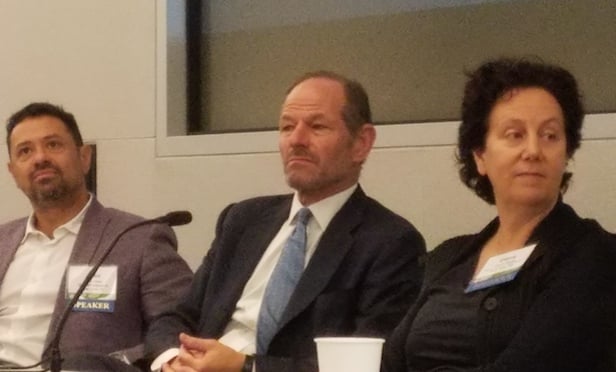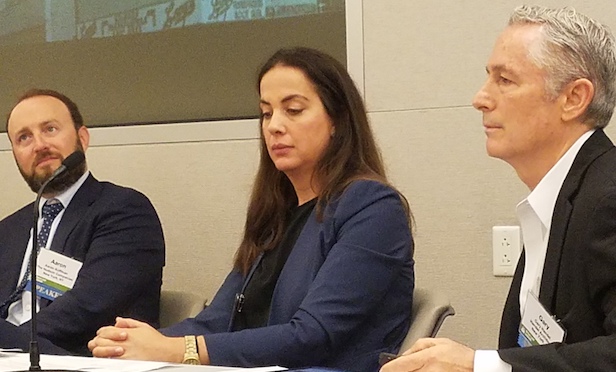 Eliot Spitzer at ULI presentation/ photo by Betsy Kim
Eliot Spitzer at ULI presentation/ photo by Betsy Kim
NEW YORK CITY—Putting back on his government hat, Eliot Spitzer said he's not so sure the 421-a program works. Calling the housing policies of the city and state misguided, the former New York governor said, “We are woefully under-housed. We are not generating nearly enough additional housing.”
“The dollars spent per unit of affordable housing we are getting are way too high,” he continued. “The reason for that is the laws were crafted by people who are beneficiaries—developers and builders and not the public at large. We need to step back and say where we get a better bang for our buck and the answer in one word is transportation.”
If you want to build a city, you build transportation, according to Spitzer. This provides access to the central business district, and results in enormous growth of public and private capital. He added that building transportation would increase housing in “multiples of the numbers we are getting right now through programs that concentrate excess dollars per square foot on a limited number of projects. That's simple numbers and arithmetic.”
He also commented that the creation of parks generate flow of capital back into the city. The family's real estate business which he now heads, Spitzer Enterprises, recently opened 420 Kent Ave. for leasing. The three 24-story glass towers house 857 units, of which 65 were available through the affordable housing lottery. The development borders the Esplanade park on the East River waterfront in Williamsburg.
Spitzer was one of the speakers at ULI's panel on high-design, mixed-income and new urban housing in Greater New York.
 From left: Eran Chen, Eliot Spitzer, Claire Weisz/ photo by Betsy Kim
From left: Eran Chen, Eliot Spitzer, Claire Weisz/ photo by Betsy KimEran Chen, founding principal of ODA Architecture, which designed 420 Kent Ave. was also on the panel. The traditional idea of separating affordable housing in a different location “brought many social problems,” said Chen. But people are getting used to commingling. “Actually, it's a brilliant idea to bring people who cannot afford these developments into it and to create a community,” he added.
Gary Handel is the managing partner at Handel Architects, one of the firms working on the Essex Crossing development. The 1.9 million square-foot development will offer 1,079 residences, of which 579 are affordable housing. He agreed with Chen's opinion and stated, “The goal of the entire project is to make the buildings with the lower income components indistinguishable from the market-rate components.”
Handel explained why Essex Crossing is one of the most hotly disputed and controversial pieces of land in the city. In 1958, Robert Moses with the “slum clearance committee” demolished 14 blocks in the Lower East Side. This action resulted in the displacement of more than 7,000 people, many of whom were immigrants according to Handel. He sees Essex Crossing as “community reparations for an event that happened 50 years ago.”
 From left: Aaron Koffman, Colleen Wenke, Gary Handel/ photo by Betsy Kim
From left: Aaron Koffman, Colleen Wenke, Gary Handel/ photo by Betsy KimPanelist Colleen Wenke, SVP at Taconic Investment Partners, one of Essex Crossing's developers, stressed community feedback was essential for the success of the project. She noted the project allowed for flexibility. For example, after community conversations, the developers increased the number of affordable units in one of the rental buildings. They were able to do this by increasing the market-rate units in a separate building.
“It's toggling and understanding what can work and based on the programs at hand and a long-term perspective of what you are delivering to the community,” says Wenke. “And that conversation will continue to evolve.”
Aaron Koffman, principal of the real estate firm Hudson Companies, Inc., and Claire Weisz, the founding partner of the architecture and design firm, WXY are both working on creating the Peninsula, after demolishing the Spofford Juvenile Detention Center. The 740-unit development in the Bronx will be 100% affordable. He described the growing complexities of working with federal, state and local programs with a massive development.
The days of off-the-shelf programs where there were no gaps, the programs just worked and everybody just showed up for the groundbreaking—those days are over. So far, the Peninsula will require 13 sources of capital.
Weisz noted that even with the complexities and challenges of affordable housing, it's important to treat buildings as if they are being constructed to last into the future.
© Touchpoint Markets, All Rights Reserved. Request academic re-use from www.copyright.com. All other uses, submit a request to [email protected]. For more inforrmation visit Asset & Logo Licensing.







